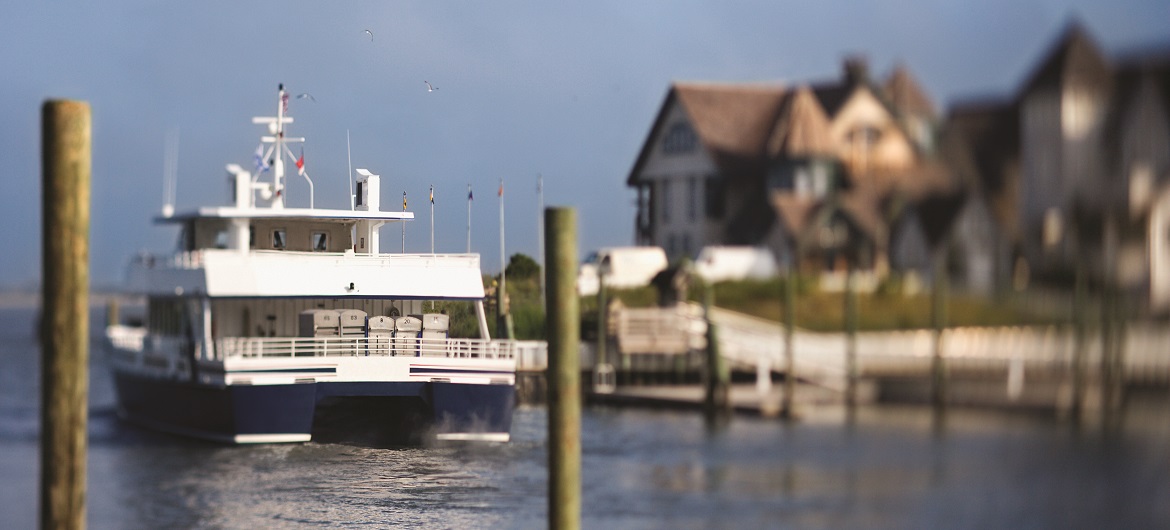
Traveling by Ferry on North Carolina’s Coastline
By Lynn & Cele Seldon
Since the mid-1920s, ferries have carried people and vehicles all around eastern North Carolina. From Southport in the southeastern part of the state all the way up throughout Ocracoke, Hatteras, and Knotts Island, North Carolina’s RVer-friendly ferries can be a convenient and enjoyable way to spend time traveling along the coast.
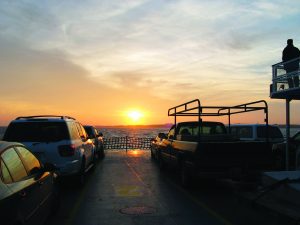
NC Car Ferry at Sunset
Early ferries were privately-operated and connected the region’s small coastal communities. Operations like that of Captain Toby Tillett served North Carolina’s fabled Oregon Inlet and other waterways. They were originally created to provide transportation for people, food, medicine, and other goods and services.
The State of North Carolina began subsidizing the private ferries in 1934 and, in 1947, the state’s Department of Transportation launched the first route of the North Carolina Ferry Division (between Manns Harbor and Roanoke Island). The system has expanded over the years to become one of the largest ferry operations in North America, with multiple routes and more in the planning stages.
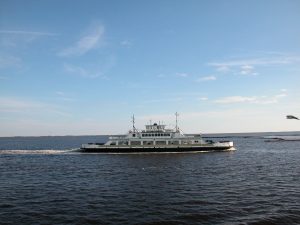 With 21 ferries operating and more than 400 permanent employees on staff, North Carolina’s ferry system is second only to Washington State’s 28-ferry fleet in size. Ferries operate on Currituck and Pamlico sounds, as well as the Neuse, Pamlico, and Cape Fear rivers.
With 21 ferries operating and more than 400 permanent employees on staff, North Carolina’s ferry system is second only to Washington State’s 28-ferry fleet in size. Ferries operate on Currituck and Pamlico sounds, as well as the Neuse, Pamlico, and Cape Fear rivers.
In a typical year, more than 2.5 million residents and visitors—and more than one million vehicles—ride North Carolina’s coastal ferries. “Not only are North Carolina’s ferries a vital transportation link for coastal communities, they are also a great way to explore our state,” says Ed Goodwin, the director of the state’s Ferry Division.
Starting Out
Since we live on Oak Island, near Southport, starting from the state’s southernmost Southport ferry and proceeding up the coastline is an obvious choice for us—and is easily repeatable for RVers coming from the south. If we have time, we head to the waterfront’s Yacht Basin Provision Company (130 Yacht Basin Drive) for the great views, grouper salad, steamed shrimp, crab cakes, and more.
We like to spend several nights enroute, but the beauty of taking the ferry is that you have lots of flexibility. Of course, this trip could easily be done in reverse if you were coming from the north or even expanded to include more overnights along the way.
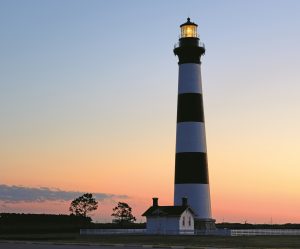
Bodie Island Lighthouse
The Southport ferry is already a familiar way for us to get from Oak Island to Carolina Beach, Wilmington, and further afield. This quick crossing of 30 minutes is one of the shortest ferry rides in the system (Cherry Branch to Minnesott, at 20 minutes, is the shortest). Driving onto the ferry—and the feeling of anticipation it brings—is always one of the most enjoyable parts of any trip across the water. The process is efficient and, even on large or crowded ferries, we’re always amazed how many vehicles (anywhere from 18 to 53) they can pack onto the variously-sized vessels.
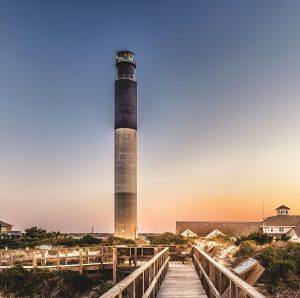
Oak Island Lighthouse
The Southport-Fort Fisher ferry offers year-round service, with a couple of additional trips in summer and winter to accommodate both commuters and vacationers. On our most recent trip, one of the crew members saw us looking at Oak Island’s lighthouse through binoculars and he informed us that this run is the only route where passengers can see three lighthouses in one trip (the other two are Bald Head Island’s beloved Old Baldy and Price’s Creek Lighthouse). He also explained the unique color schemes of the boats—our ferry that day was painted with the colors of Duke University, while other ferries in the system are painted with the colors of other universities and colleges throughout the state.
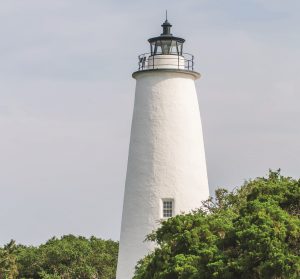
Ocracoke Island Lighthouse
Far too quickly, we reach the ferry docks at Fort Fisher and we drive back onto land. The drive through Fort Fisher, which was an important Civil War Confederate stronghold, leads past the wonderful North Carolina Aquarium at Fort Fisher, making for a great stop for veteran state aquarium addicts like us (as well as first-timers destined to become addicted).
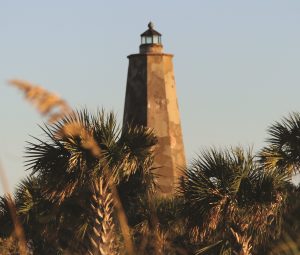
‘Old Baldy’ Lighthouse
The next ferry on a tour of the system leaves from quiet Cedar Island, and the drive northeast out of Morehead City is especially pretty and shouldn’t be rushed (plan on about an hour or so). If we have time we stop for seafood at Morehead City’s beloved and uniquely-named Sanitary Fish Market (501 Evans Street). The Cedar Island-Ocracoke ferry can be a real time- (and gas-) saver for those traveling along the coast. Thanks to its length and scenery, it’s also become one of our favorite routes. The route in either direction typically takes about two hours and 15 minutes, but after the four-hour drive from Fort Fisher to Cedar Island, it’s nice to let someone else do the “driving” the rest of the way to Ocracoke.
The trip from Cedar Island to Ocracoke offers lots of time for wildlife watching, talking to fellow passengers or crew members (which typically number from four to six), and thoroughly exploring your chosen mode of transportation. On this route one time, a crew member mentioned that the ferry service’s home port and a repair and maintenance facility are based in Manns Harbor. He also told us that two of the ferries were actually built in New Bern Shipyard and that today’s ferries average about 10 knots and can float in as little as six feet of water even when fully loaded.
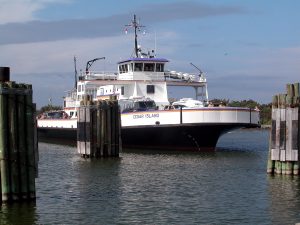 The Cedar Island-Ocracoke ferry arrives and departs right in “downtown” Ocracoke Village’s Silver Lake Harbor. Ocracoke Village is ideally explored on foot and the leisure options in Ocracoke include fishing, kayaking, a couple of small museums, shopping, and more, including visiting the squatty 75-foot Ocracoke Lighthouse and checking the menus of various restaurants. Back Porch Restaurant, features fresh seafood dishes, which are prepared plainly or served with interesting sauces. Freshly-baked breads, sumptuous desserts, seating on a screened porch, and friendly service all enhance the Back Porch experience.
The Cedar Island-Ocracoke ferry arrives and departs right in “downtown” Ocracoke Village’s Silver Lake Harbor. Ocracoke Village is ideally explored on foot and the leisure options in Ocracoke include fishing, kayaking, a couple of small museums, shopping, and more, including visiting the squatty 75-foot Ocracoke Lighthouse and checking the menus of various restaurants. Back Porch Restaurant, features fresh seafood dishes, which are prepared plainly or served with interesting sauces. Freshly-baked breads, sumptuous desserts, seating on a screened porch, and friendly service all enhance the Back Porch experience.
From Ocracoke to Hatteras
A 16-mile drive along the Atlantic Ocean through Cape Hatteras National Seashore takes explorers to the popular Ocracoke-Hatteras ferry. Each day, workhorse ferries depart both Ocracoke and Hatteras every hour from early morning to late at night, with service additions from spring to fall. This 40-minute crossing is unique in that it is one of four Ferry Division offerings that’s offered free of charge. The other three are: Currituck-Knotts Island; Bayview-Aurora; and Cherry Branch-Minnesott. The reason for the free rides is to accommodate the large numbers of commuters, as well as the many school students who travel by ferry every day.
From the fishing village of Hatteras, it’s time to head further along the coastline, with occasional stops on both sides of the road to enjoy lots of protected wildlife and scenery—still within Cape Hatteras National Seashore. There’s also the Cape Hatteras Lighthouse in Buxton and the Bodie Island Lighthouse in southern Nags Head.
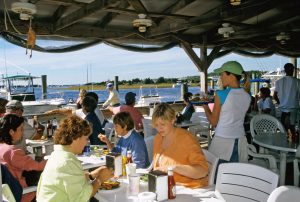
Next, it’s easy to head to Manteo for a fun waterfront lunch, including Poor Richard’s Sandwich Shop (303 Queen Elizabeth Avenue), where the creative made-to-order sandwiches (often featuring local seafood) are worth the short drive inland to quaint Manteo. From Manteo, the “slow” road leads along the beach to marvel at many houses precariously perched above the sand (and sometimes waves). This is a classic “Outer Banks” drive, including a stop at the Wright Brothers National Memorial in Kill Devil Hills.
During a trip north or south using the ferry system, coastal explorers will inevitably contemplate continuing the ferry adventure by retracing the drive and ferry routes—or maybe even trying one of the other options to the north and south. Many RVers may decide to complete the “circle” by driving back on US highways 64 and 17 and comparing the two experiences.
The return drive is typical uneventful and we often find ourselves yearning for the next time we’ll drive onto a ferry. We decided that you can’t simply compare driving and ferry riding in terms of cost and time. In the end, getting there can truly be half the fun—especially if you take the ferry.
For more information
Visit the Ferry Service’s website at www.ncferry.org for information and schedules or call (800) 293-3779. You can also call 511, the state’s free travel information hotline, to check on road conditions on your way to or from the ferry.
Visit thousandtrails.com to plan your trip towards the NC Coastline.

